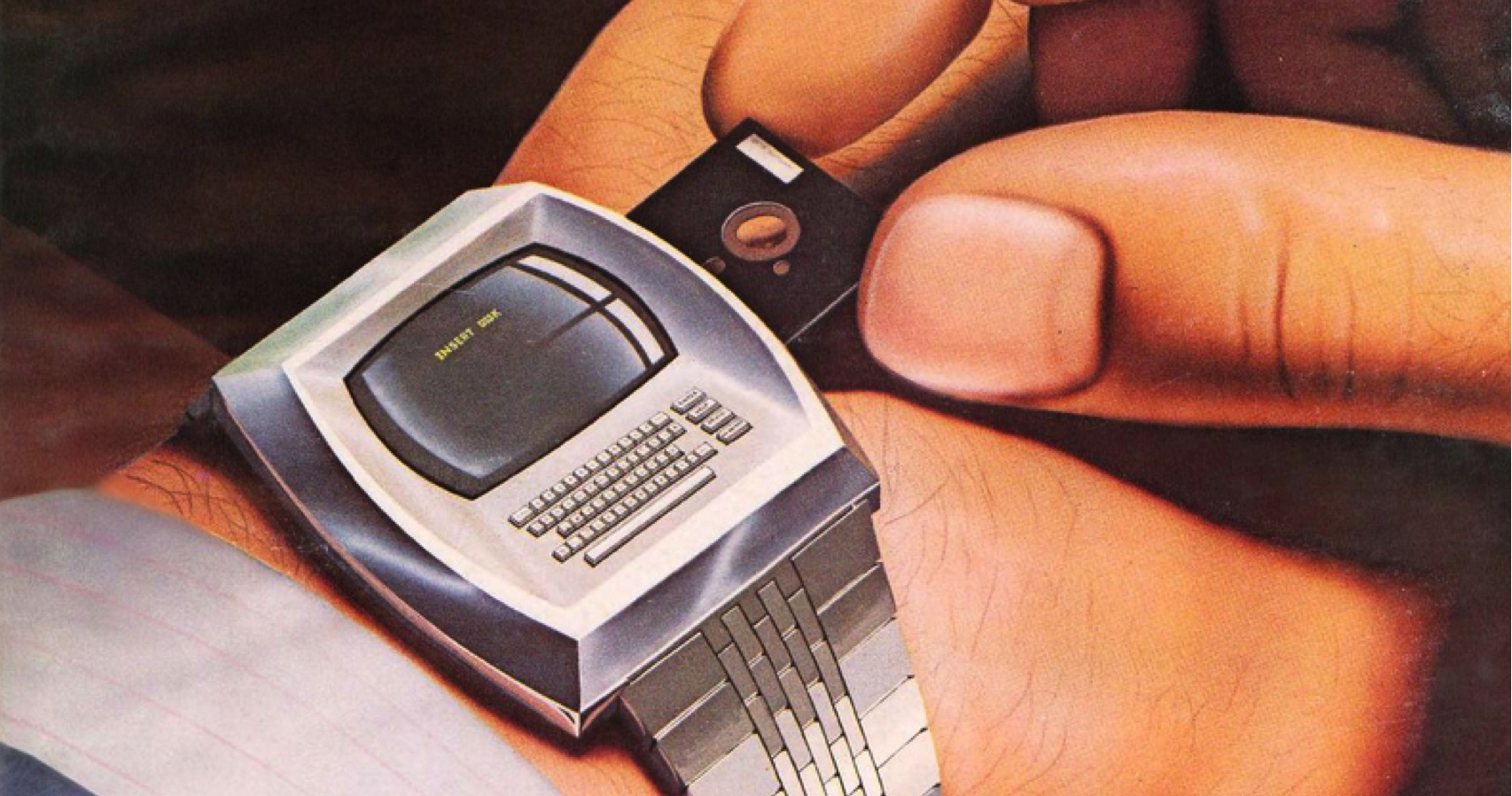This blog post reveals how the smartwatch is the result of technological evolution, rather than a predetermined long-term plan. Decades of competition between watch manufacturers who developed new functionality provided variation, while consumers applied selective pressure. This shaped the evolutionary path for the smartwatch. As there is no reason to assume the evolution of the smartwatch has ended, a logical question is where will it lead?
Figure 1 shown here is an artist’s impression by Robert Tinney of the future of computing that featured as cover of Byte magazine in 1981. Inside the magazine the editor pointed out the proximity of April 1st (Source: Internet Archive). Despite the tongue-in-cheek comments, current smartwatches wouldn’t disappoint Dick Tracy, who introduced a proto-smartwatch idea in a cartoon as early as 1946.
Lost in time
Mechanical watches may now seem lost in time, but for long they have been a hallmark of progress. Handheld watches have been around for centuries and for most of that time the energy required by their mechanism was stored in a spring. In the mid 20th century battery-powered electric watches were introduced using various electro-mechanical systems to keep them ticking. The timepiece accuracy was improved by the introduction of the electronic oscillator that provided the precision heart beat. The Seiko Quartz Astron released in 1969 was the first in this new branch of watches. Progressing miniaturisation of electronics made it possible in the 1970 to make further changes to how watches were made, look and function. The introduction of LED and LCD displays made it possible to replace the numerical dial and moving hands, and allowed the inclusion of functionality that was previously not possible. These developments paved the way for the smartwatches.
Functionality grows over time
For a long time the functionality of a watch was simple and straightforward: display the time and, of course, that included related matters like day and date. The introduction of microprocessors changed all that. In 1972 the first digital watch named Pulsar P1 was introduced by The Hamilton Watch Co. Encouraged by the success they moved on and introduced the Pulsar 901 in 1975, which became known as the first ever calculator watch. It contained a six-digit display and keys so small a stylus was provided with it to tap the keys.
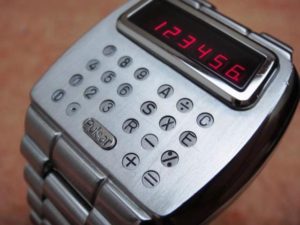
Soon other companies like Casio, HP and Seiko offered similar calculator watches. Competition between the growing number of manufacturers fuelled an increase in functionality. Casio launched the Databank series, debuting with the CD-40 in 1984, that also allowed storing data like telephone numbers and memos. Obviously the miniature keyboards used for these watches were very impractical. Remarkably, the Databank series is still being sold more than three decades after its introduction.
The Japanese company Seiko has developed several forerunners of the current smartwatch. In 1982 Seiko released the T001 TV watch that featured a 1 ¼ inch monochrome LCD screen. The image quality was poor, but that did not compromise the high-tech image of the TV watch.
The advent of home computers, that later became known as personal computers (PCs), at the end of the 1970s and early 1980s also influenced watch evolution. It prompted Seiko to introduce the RC-1000 Wrist Terminal in 1984 that could interface with most popular PCs of that time using a cable. A decade later Timex introduced the Datalink wristwatch that used a blinking protocol to transfer information like appointments and contacts from a PC screen to the watch. In fact, this functionality meant it was competing with the personal digital assistant (PDA), which turned out to be a precursor of the smartphone.
Another Seiko first was the message watch introduced in 1995 that could display caller ID and various news flashes like sports scores, stock prices and weather forecasts. Functionality in watches continued to grow. In 1999 Samsung launched the SPH-WP10 that offered up to 90 minutes talk time and became known as the worlds first phone watch.
This clunky device could provide an electronic breadcrumb trace allowing geeky boy scouts running new trails to find their way back
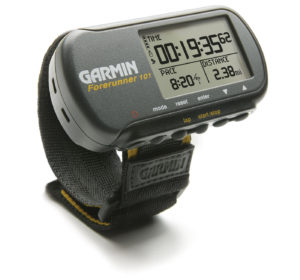
Garmin was the first to introduce a GPS watch, the Forerunner 101, in 2003. This clunky device could provide an electronic breadcrumb trace allowing geeky boy scouts running new trails to find their way back. It could also serve as a virtual training buddy or digital running coach by providing various clues like distance, average speed and pace.
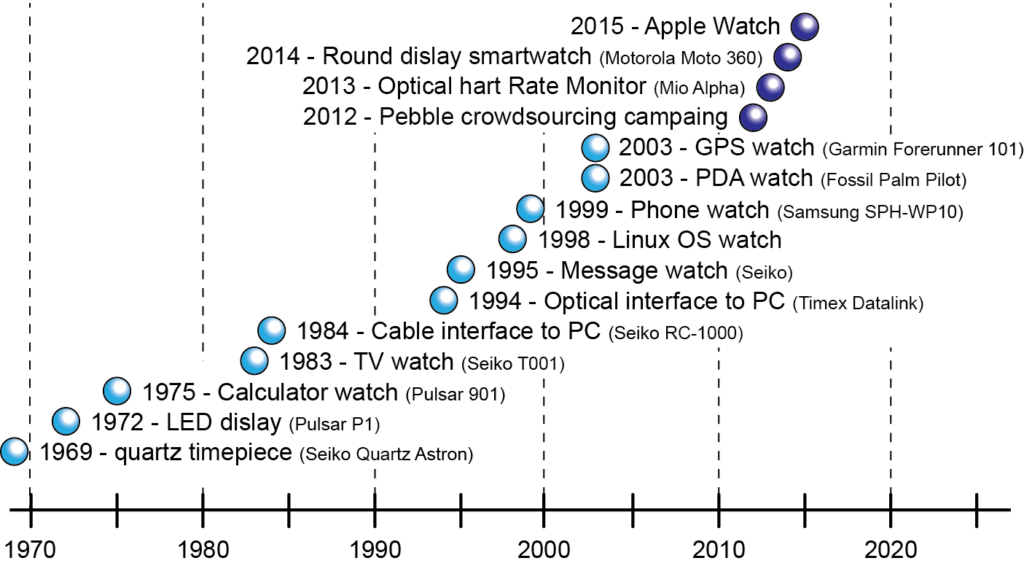
Operating Systems enter the watch
The computer watch emerged when Steve Mann in 1998 first used Linux as an Operating System (OS) in a watch. IBM then introduced the Linux based WatchPad in 2001 that also included an accelerometer, fingerprint sensor and vibrating mechanism. A first PDA watch became available in 2003 with the introduction of the Fossil Palm Pilot that was using Palm OS.
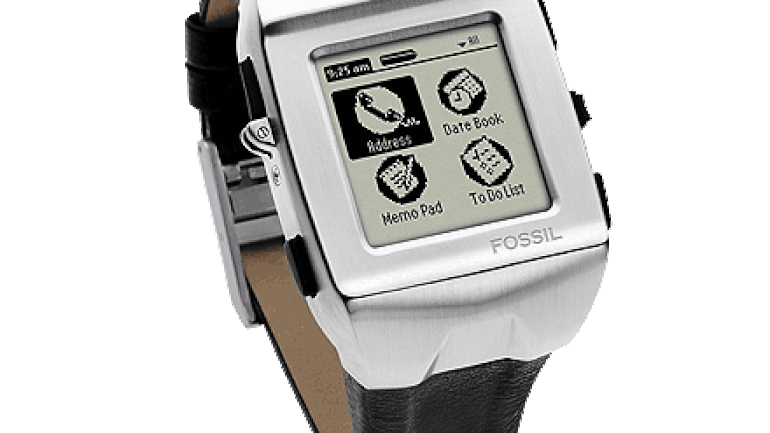
Development efforts targeting PDAs and later smartphones provided ever more advanced OS types that are crucial for using third party apps on computing devices. Various OS types for watches are currently being used. The dominant types currently are WatchOS by Apple and Tinzen that is used by Samsung. Both these OS are UNIX like.
The smartwatch emerges
The year 2012 became a turning point in the evolution of the smartwatch. That year Pebble set a Kickstarter record by raising over 10 million dollars in a crowdfunding campaign for their smartwatch, a sign that a growing group of consumers was starting to become interested. The Pebble Smartwatch was launched in 2013 and is referred to as the first of this new type of product that was commercially successful. Also in 2012, another successful Kickstarter crowdfunding campaign enabled the company Mio Global to develop the first fitness tracker using Optical Heart Rate Monitor (OHRM) technology developed by Philips. Their first OHRM product, the Mio Alpha, was released in 2013.
Motorola added to smartwatch diversity with their release of the Moto 360 in 2014. The Moto 360 drew a lot of attention because of its sleek round design. Then, in 2015, the Apple Watch was released and set the scene for a next level of functionality and competition in what became known as the smartwatch.
As laid out in the preceding section, the functionality provided by the watches has evolved a lot over time and in recent years functionality previously provided by different types of watches became available in a single computerized device. The wide availability of smartphones that provide an interface, communication and computing hub for smartwatches also played a significant role in these developments.
The wrist appears to be a hotspot for experiments with wearable technology
The wrist appears to be a hotspot for experiments with wearable technology. The ongoing miniaturization of electronics allowed recent smartwatches to include many different sensors, including a gyroscope, accelerometer and OHRM, that make them useful tracking your physical activity. Tracking fitness appears to be just one of the many functionalities that can be assigned to a wrist-worn device. This development and the emergence of various other ‘smart devices’ have contributed to the common use of the designation smartwatch as a generic name for this writ worn new type of product. Devices dedicated to just tracking fitness parameters have become known as activity or fitness trackers. However, leading smartwatches also offer the same functionality. Confusion is therefore an obvious issue.
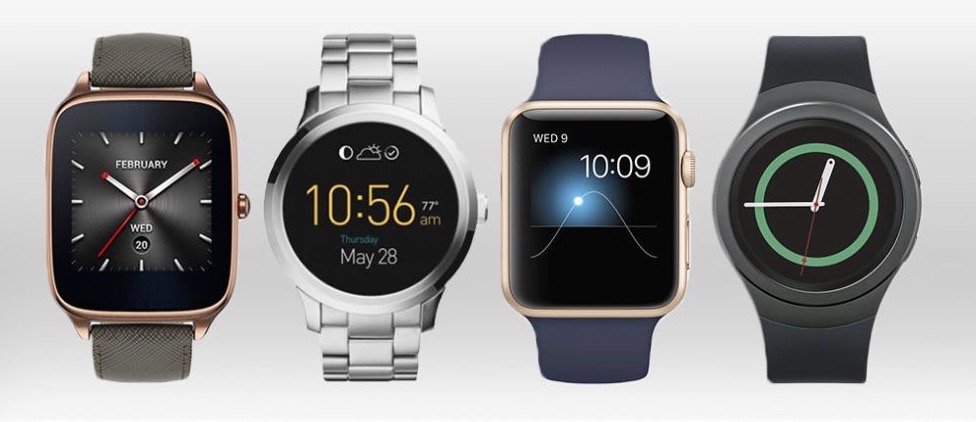
Currently most popular smartwatches (Apple Watch, Samsung Gear S3) feature a similar long list of functions and include GPS and OHRM. The OLED touch screens allow for interaction and display that would have been pure science fiction in the days of the Seiko TV watch. Watch faces can now be customized and that not only improves the User Interface quality but also turns the smartwatch into a fashion item.
All data connectivity is now wireless using Bluetooth, WiFi and some also use 4G mobile phone network technology (LTE). Even the battery that only lasts between less than one day and several days can now be recharged wirelessly.
As explained above, decades of smaller and larger steps in watch evolution took place before the smartwatch emerged as a new type of product. These decades of development in watches and far beyond allowed experimentation with functionality and technology that greatly increased watch variation. Consumer purchasing behaviour subsequently applied selective pressure. Certain watch variations sold well and fuelled further development. Others appeared to be less popular and were discontinued. And, of course, technology developed for other products like PDAs and smartphones also contributed a lot to the process. Clearly the smartwatch is not the result of a predetermined plan drawn up four decades ago. Instead, the emergence of this new type of product can be explained by the accumulated technological development and interaction between stakeholders.
Displaying time not a top priority for a watch anymore?
Research by NPD provides an overview of how people use smartwatches. Although it is not clear if a question about the function ‘display the time’ was included in the research, the results suggest that showing the time is no longer a primary function of smartwatches. The time-related alarm clock function was ranked sixth. NPD also notes that their research ‘demonstrates a natural evolution of the device as a home control hub on the wrist, for one, and continued evolution of product capabilities will be key to winning over consumers.’
As can be expected ownership is highest amongst millennials. Remarkably, the lowest income category (below $45,000 per year) shows highest ownership rates. NPD remarks these people probably work ‘in the service industry who need a device to check incoming notifications when they can’t reach for their phone’.
Showing the time is no longer a primary function of smartwatches
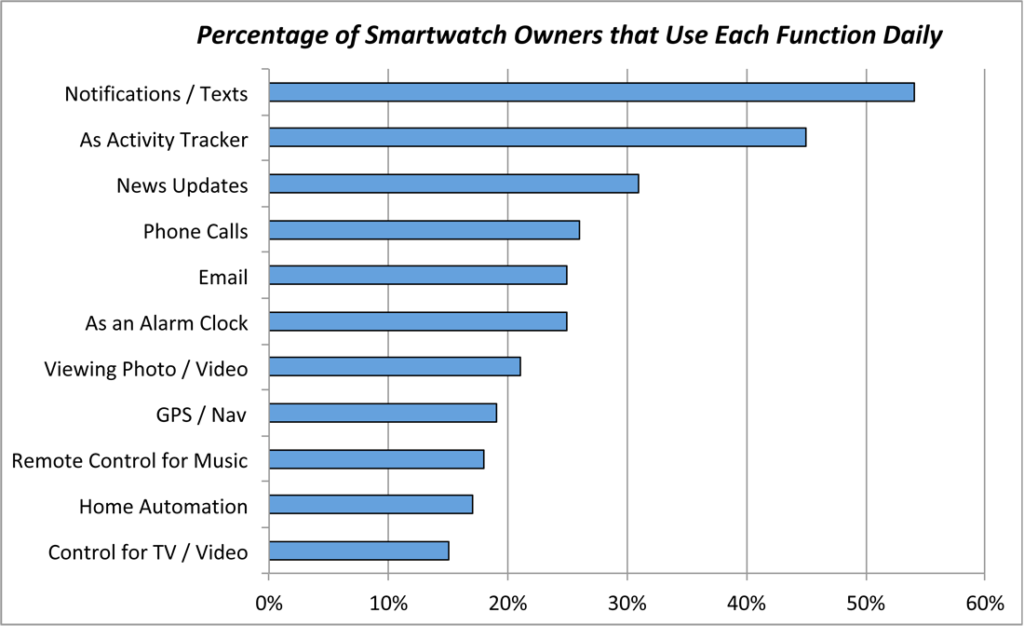
Watch the future
The Google Glass experiment showed how underestimated privacy concerns can have a devastating impact on an advanced new type of product. And privacy concerns are likely to continue to grow the more pervasive new smart products become. According to The Guardian of 18 November 2017, the German telecom regulator has banned smartwatches for children with GPS tracking functionality because of privacy concerns. These watches allow parents to track the location of children and to eavesdrop on them. The quality of the security protocols used in the disputed watches is called into question and concerns are raised that ‘third parties’ could also listen in. This prompted the regulator to ask parents to destroy all the smartwatches in question. Privacy concerns obviously influence how we think and feel about wearable technology, and probably how functionality will evolve in the future.
The regulator requested parents to destroy all smartwatches in question
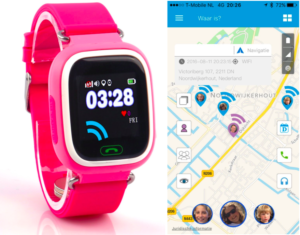
Predicting how technologies and products will evolve in the future is highly speculative. However, it is clear that boundaries between devices are becoming blurred. Thanks to increasing computing power and ever-smaller microelectronics, functionality that was reserved for smartphones only a few years ago can now also be found in smartwatches. And it is safe to bet on functionality continuing to grow.
Because the smartphone has a much larger screen, it will probably continue to play a role in controlling the smartwatch. Today’s smartwatches can already use virtual assistants such as Siri. It will be interesting to see how the role of the smartwatch in accessing cloud-based functionality will evolve. Future smartwatch functionality could include a type of personal identification alternative to the implanted chip advocated by many techno-prophets. Probably many people will dread the Black Mirror thought of such an implanted chip. A much less invasive solution would be to use a smartwatch-based alternative to open doors, control IoT devices like lights, or order a robot taxi.
It is quite likely that different types of use will offer niches for the evolution of different smartwatches variants. Competing companies will drive those developments in an effort to conquer future markets. Future smartwatches will arguably include functionality based on Artificial Intelligence (AI), as this is the domain of great technological promise. Consumers referred to as innovators and early adopters will experiment with the new functionality provided. And legislators will (have to) consider whether or not new privacy rules should be introduced as a result of new functionalities of these new devices. As is often the case with such developments, technology can be expected to develop faster than legislation. Ultimately, an evolutionary process will shape the future of the smartwatch.
The chances are that, at a certain moment in the future, we will start using new names for the descendants of today’s smartwatches. Only in retrospect will we be able to tell when that happened and what new types of wrist-worn devices evolved.
Copyright © 2017 Huub Ehlhardt. All Rights Reserved. Please contact us for re-use of this article.
The book ‘On the Origin of Products’ is available via Cambridge University Press and Amazon. This site also provides an introduction to this title.
